Abstract
We consider the use of so-called top-points for object retrieval. These points are based on scale-space and catastrophe theory, and are invariant under gray value scaling and offset as well as scale-Euclidean transformations. The differential properties and noise characteristics of these points are mathematically well understood. It is possible to retrieve the exact location of a top-point from any coarse estimation through a closed-form vector equation which only depends on local derivatives in the estimated point. All these properties make top-points highly suitable as anchor points for invariant matching schemes. In a set of examples we show the excellent performance of top-points in an object retrieval task.
Preview
Unable to display preview. Download preview PDF.
Similar content being viewed by others
References
Balmachnova, E., Florack, L.M.J., Platel, B., Kanters, F.M.W., ter Haar Romeny, B.M.: Stability of top-points in scale space. In: Proceedings of the 5th international conference on Scale Space Methods in Computer Vision, Germany, April 2005, pp. 62–72 (2005)
Damon, J.: Local Morse theory for solutions to the heat equation and Gaussian blurring. Journal of Differential Equations 115(2), 368–401 (1995)
Ertoz, L., Steinbach, M., Kumar, V.: Finding clusters of different sizes, shapes, and densities in noisy, high dimensional data. In: Proc. of SIAM DM 2003 (2003)
Florack, L., Kuijper, A.: The topological structure of scale-space images. Journal of Mathematical Imaging and Vision 12(1), 65–79 (2000)
Florack, L.M.J., ter Haar Romeny, B.M., Koenderink, J.J., Viergever, M.A.: Scale and the differential structure of images 10(6), 376–388 (1992)
Florack, L.M.J., ter Haar Romeny, B.M., Koenderink, J.J., Viergever, M.A.: Cartesian differential invariants in scale-space. Journal of Mathematical Imaging and Vision 3(4), 327–348 (1993)
Harris, C., Stephens, M.: A combined corner and edge detector. In: Proc. 4th Alvey Vision Conf., pp. 189–192 (1988)
Johansen, P., Skelboe, S., Grue, K., Andersen, J.D.: Representing signals by their top points in scale-space. In: Proceedings of the 8th International Conference on Pattern Recognition, Paris, France, October 1986, pp. 215–217. IEEE Computer Society Press, Los Alamitos (1986)
Koenderink, J.J.: The structure of images. Biological Cybernetics 50, 363–370 (1984)
Lindeberg, T.: Scale-space theory: A basic tool for analysing structures at different scales. J. of Applied Statistics 21(2), 224–270 (1994)
Lowe, D.G.: Distinctive image features from scale-invariant keypoints. Int. J. Comput. Vision 60(2), 91–110 (2004)
Mikolajczyk, K., Schmid, C.: A performance evaluation of local descriptors. Submitted to PAMI (2004)
Mikolajczyk, K., Schmid, C.: Scale and affine invariant interest point detectors. International Journal of Computer Vision 60(1), 63–86 (2004)
Platel, B., Fatih Demirci, M., Shokoufandeh, A., Florack, L.M.J., Kanters, F.M.W., Dickinson, S.J.: Discrete representation of top points via scale space tessellation. In: Proceedings of the 5th international conference on Scale Space Methods in Computer Vision, Germany (April 2005)
Schmid, C., Mohr, R., Bauckhage, C.: Evaluation of interest point detectors. Int. J. Comput. Vision 37(2), 151–172 (2000)
Author information
Authors and Affiliations
Editor information
Editors and Affiliations
Rights and permissions
Copyright information
© 2005 Springer-Verlag Berlin Heidelberg
About this paper
Cite this paper
Platel, B., Balmachnova, E., Florack, L.M.J., Kanters, F.M.W., ter Haar Romeny, B.M. (2005). Using Top-Points as Interest Points for Image Matching. In: Fogh Olsen, O., Florack, L., Kuijper, A. (eds) Deep Structure, Singularities, and Computer Vision. DSSCV 2005. Lecture Notes in Computer Science, vol 3753. Springer, Berlin, Heidelberg. https://doi.org/10.1007/11577812_19
Download citation
DOI: https://doi.org/10.1007/11577812_19
Publisher Name: Springer, Berlin, Heidelberg
Print ISBN: 978-3-540-29836-6
Online ISBN: 978-3-540-32097-5
eBook Packages: Computer ScienceComputer Science (R0)




